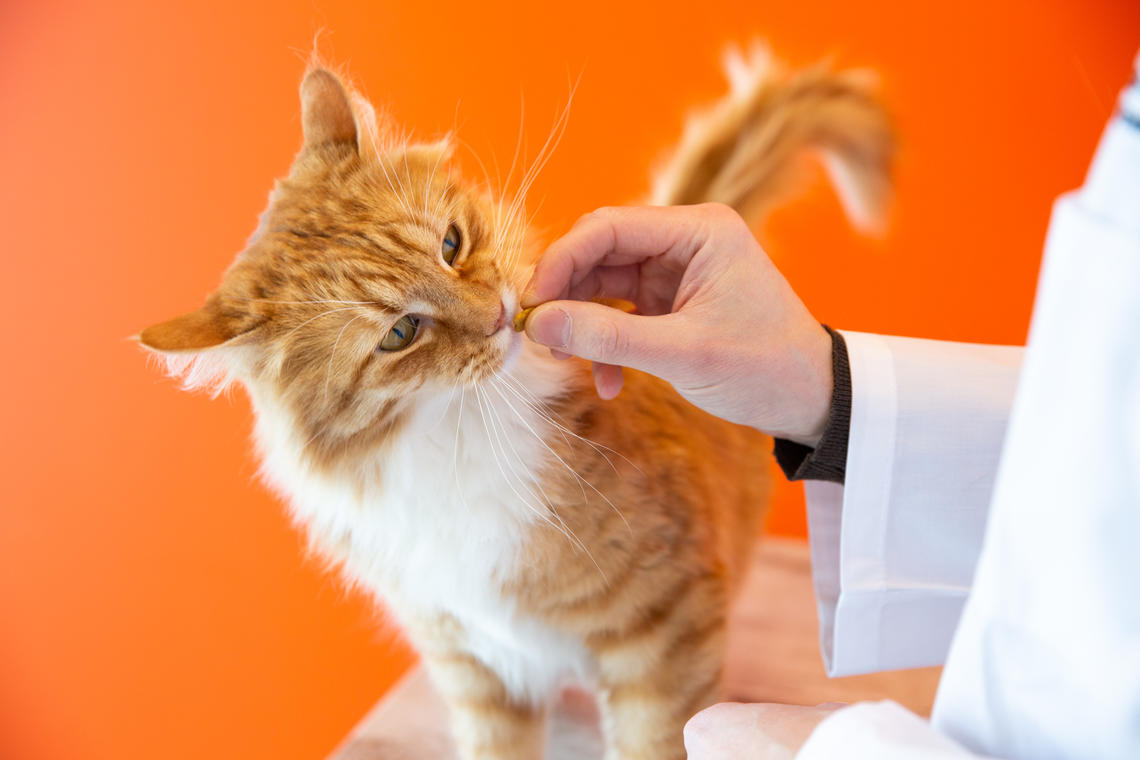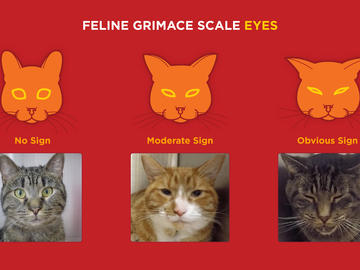Jan. 17, 2020
Cats’ faces reveal their hidden pain

Cats are notorious for hiding their pain. But despite this tendency to suffer in silence, the feline face speaks volumes about the pain it’s feeling.
Veterinary researchers recently published a paper in Scientific Reports on the Feline Grimace Scale, a fast, easy way of assessing a cat’s facial expressions to help determine how much pain it is feeling.
The scale assesses five features: the position of the cat’s ears, head, and whiskers, whether its eyes are open or closed (orbital tightening), and muzzle tension. “All of these things reflect whether there's tension in the face,” says Dr. Daniel Pang, PhD, associate professor of anesthesia and analgesia at the University of Calgary Faculty of Veterinary Medicine (UCVM). Pang, along with Dr. Paulo Steagall, PhD, was co-author of the study and co-supervisor of the study’s lead author, Marina Evangelista, a PhD student at the Université de Montréal.
Vets less likely to prescribe painkillers for cats
Cats are often undertreated for pain and studies show they are prescribed fewer painkillers than dogs. “Veterinarians always say the same thing — they are unsure how best to assess pain, and they're not comfortable doing it because they don't feel they have the right assessment tools,” says Pang, a veterinary pain researcher whose previous work on a grimace scale for rats was the foundation for designing the new Feline Grimace Scale. “Everything we learned from the rodent work, we kind of switched out that species and adapted it to cats.”

Researcher Daniel Pang co-authored the study on how feline facial expressions indicate pain.
Riley Brandt, University of Calgary
Existing pain scoring scales for cats have limitations such as being time-consuming to implement or validity tested for a single type of pain stimulus, for example spay surgery. “It doesn't matter how good or well-designed it is, if it’s not practical to use in a clinic it just doesn’t get used,” says Pang.
New tool to help patients who can’t tell you if they hurt
The study compared the new grimace scale with a more complex pain assessment scale in dozens of cats that were brought into the Université de Montréal’s veterinary hospital in acute pain, and subsequently given pain medication. “We were able to show that the scale we'd developed worked as well, and was as sensitive, as the more complicated scale,” says Pang.
The Feline Grimace Scale measures the absence or presence of signs of pain including ears flattened and rotated outward, squinted eyes, whiskers that are bunched together, and if the cat’s muzzle is tense and their head is lowered. Each of the five facial indicators is given a score of zero (sign absent), one (moderate sign) or two (obvious sign). The study also determined a threshold score, above which cats are more likely to be in pain and analgesia pain relief should be considered.
The researchers hope their new diagnostic tool will help veterinarians and other veterinary care professionals identify and treat cats suffering acute pain. The published paper includes a downloadable training manual.
“Now we have something so you walk up to the cat, look at it and you make your assessment within seconds. It's got the attractive features of being tested, practical, and it takes advantage of the fact that we're familiar with them and their little faces anyway. So why not make the most of it?” says Pang.
But what about cat owners?
“At the moment that's a big unknown,” says Pang. “But the thought process is exactly the same. And cat owners are great because they know their cat so well when they see a change, they tend to spot it anyway. It's just the interpretation of that change that's not always that obvious.”
For the past few decades, momentum has been building in developing pain assessment tools for a variety of different animals. “From lab animals, development of grimace scales moved into farm animals. There are scales for horses, sheep, pigs, and ferrets. There's one for seals.”
But don’t hold your breath for a simple grimace scale to assess a dog’s pain. “The breeds differ so much in the shape of their faces that this poses a real challenge to come up with a scale that works for all breeds,” says Pang.

The Feline Grimace Scale should help vets identify and treat cats who are in acute pain.
Riley Brandt, University of Calgary






